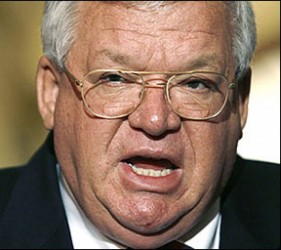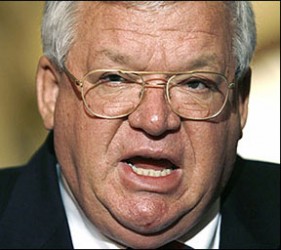St. LOUIS, (Reuters) – Many criminals and some legitimate businessmen who don’t want the U.S. government to be informed of their financial activity rely on a simple tactic: break up bank deposits and withdrawals so that each is under $10,000.
In reality, though, this tactic often backfires. It can expose them to closer scrutiny from both the banks and federal law enforcers than they may otherwise have attracted, said current and former law enforcement officials.

In unrelated cases, former Speaker of the House Dennis Hastert and Daryan and Daryll Warner, sons of former FIFA vice-president Jack Warner, learned the lesson the hard way. Last week it emerged that they had all been accused of the federal crime known as “structuring.”
Hastert, who left Congress in 2007, was charged with structuring the withdrawal of more than $950,000 in cash to evade a requirement that banks report cash transactions above $10,000, and lying to the Federal Bureau of Investigation about his withdrawals, prosecutors said. Hastert, scheduled for arraignment yesterday, has made no public statement since the federal charges were filed last week.
The Warner brothers and their associates deposited more than $600,000 in cash at bank branches in New York, Miami and Las Vegas in 2011, breaking the money up into smaller amounts to make sure transactions did not exceed the $10,000 threshold, according to a 2012 U.S. complaint that was unsealed last week. Both have pleaded guilty and are cooperating with prosecutors probing corruption at FIFA, while their father, who denies wrongdoing, stands accused of soliciting payments worth $10 million from the South African government.
It is not known whether the banks reported structuring by Hastert or the Warners to the Treasury Department, possibly sparking criminal investigations. It is illegal for banks to discuss whether they have filed such reports.
The reason drug traffickers and others keep deposits and withdrawals under $10,000 is that the primary U.S. anti-money laundering law, the Bank Secrecy Act (BSA), requires banks to file with the Treasury Department so-called Currency Transaction Reports, or CTRs, on transactions involving more than $10,000 in cash.
What many don’t necessarily realize, however, is that a CTR is not likely to be noticed by authorities unless the party involved was already under investigation, said a former federal agent who was responsible for reviewing such documents. What does catch the attention of law enforcers, instead, is when someone tries to prevent a bank from filing a CTR by breaking up a cash transaction, said the source.
The source, who declined to be named due to the sensitive nature of his private sector work, said: “The avoidance of a CTR gets more attention than the filing of one.”
Banks file so-called Suspicious Activity Reports, or SARs, when they suspect a customer has done something shady, like breaking up cash deposits to evade CTRs.
Congress made CTR evasion, or structuring, a crime under the Bank Secrecy Act in the 1980s because drug traffickers in Miami were using small armies of so-called “smurfs” to travel between banks and branches to make small deposits. It is punishable by up to five years in prison and forfeiture of the money involved.
Between 2009 and 2014, the Justice Department prosecuted 787 structuring cases involving 1,126 defendants, according to statistics provided by a department spokesman.
Law enforcement agencies rely heavily on bank reports on structuring in order to build cases against financial criminals, said Richard Weber, chief of Internal Revenue Service – Criminal Investigation.
“Bank Secrecy Act data and evidence of structuring have long been valuable tools for law enforcement to use as initial indications of financial and other crimes. In some cases, structuring may be the only indication that additional crimes are being committed,” Weber told Reuters.
Between March 2012 and March 2015, banks filed more than 500,000 reports warning authorities of structuring activity, according to data released by Treasury’s Financial Crimes Enforcement Network (FinCEN). Structuring is the suspicious activity that banks most often report to authorities. Although FinCEN does not publish statistics on CTR filings, between 40 million and 45 million were filed during the same time period, FinCEN spokesman Steve Hudak said.
AUTOMATED SOFTWARE
Banks rely both on tellers and automated systems adept at detecting structured transactions, scanning activity across branches on different days, including those completed at ATMs. Some systems can even spot such activity in related accounts belonging to, for instance, members of the same family.
These software solutions are offered by a number of companies, including Oracle Corp, Nice Systems , and SAS.
None of the software companies and IT specialists contacted by Reuters responded to requests for comment on the specific detection settings of their systems. Such details are often closely guarded to prevent tipping-off criminals.
“They’re generally going to look for repeat transactions that are in the $9,000 to $10,000 range,” said Rob Rowe, a former bank compliance officer and now a lawyer with the American Bankers Association, an industry trade group.
But banks may watch anything between $5,000 and $10,000 when dealing with customers deemed high-risk, he added.
When a teller spots potential structuring activity, or when automated systems detect it, the customer’s account is flagged and an investigation begins. During that probe, the bank will contact the customer and ask for an explanation of the transactions, but if the bank is not satisfied with the customer’s response, a SAR is then filed to warn authorities.
Automated systems have become sophisticated and can even help a bank determine the legitimacy of a customer’s explanation, said Michael Zeldin, a former Justice Department official.
He said the owner of a flower shop may claim he made regular $9,000 deposits because that is the amount of cash his business generated on a daily or weekly basis, but the best automated systems can pull up deposits made by similar flower shops to see if the customer’s claim bears out.










